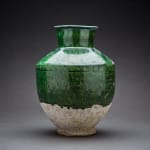Incised Green Glazed Terracotta Vase, 700 CE - 900 CE
Glazed Earthenware
25.4 x 22.2 cm
10 x 8 3/4 in
10 x 8 3/4 in
BF.135
Further images
After the death of Muhammad in 632, four caliphs known as the ‘Rightly Guided’ succeeded the sovereignty. Under their authority and command the Muslim armies carried the new faith from...
After the death of Muhammad in 632, four caliphs known as the ‘Rightly Guided’ succeeded the sovereignty. Under their authority and command the Muslim armies carried the new faith from the Arabian Peninsula all round the shores of the Mediterranean, until the eastern part of Iran. Upon the assassination of the Fourth Caliph, the governor of Syria seized the power and established the first Islamic dynasty, the Umayyad Caliphate (661-750).
Umayyad period is often considered the formative period of Islamic art. Regardless of the fact that Arabic became the official language and Islam the principal, and often the only, religion of the diverse lands unified under the Umayyad rule, artists continued to work in their established manner. As time went by though new techniques were developed, along additional or new forms and alternative decorative conventions which distinguished the latest creations from earlier works. Thus and through a process of adoption, adaptation and inspiration a new sense of artistic expression emerged, of an Islamic nature and distinctly Islamic in character.
Glazed pottery baluster vase incised with bands of linear design. Of an elegant shape eathernware.
Glaze covering only 2/3 of the whole surface, leaving the lower part of the vase unglazed, which is quite a typical feature of ceramic decoration during this period.
Round neck terminating in a round projecting rim.
Umayyad period is often considered the formative period of Islamic art. Regardless of the fact that Arabic became the official language and Islam the principal, and often the only, religion of the diverse lands unified under the Umayyad rule, artists continued to work in their established manner. As time went by though new techniques were developed, along additional or new forms and alternative decorative conventions which distinguished the latest creations from earlier works. Thus and through a process of adoption, adaptation and inspiration a new sense of artistic expression emerged, of an Islamic nature and distinctly Islamic in character.
Glazed pottery baluster vase incised with bands of linear design. Of an elegant shape eathernware.
Glaze covering only 2/3 of the whole surface, leaving the lower part of the vase unglazed, which is quite a typical feature of ceramic decoration during this period.
Round neck terminating in a round projecting rim.







